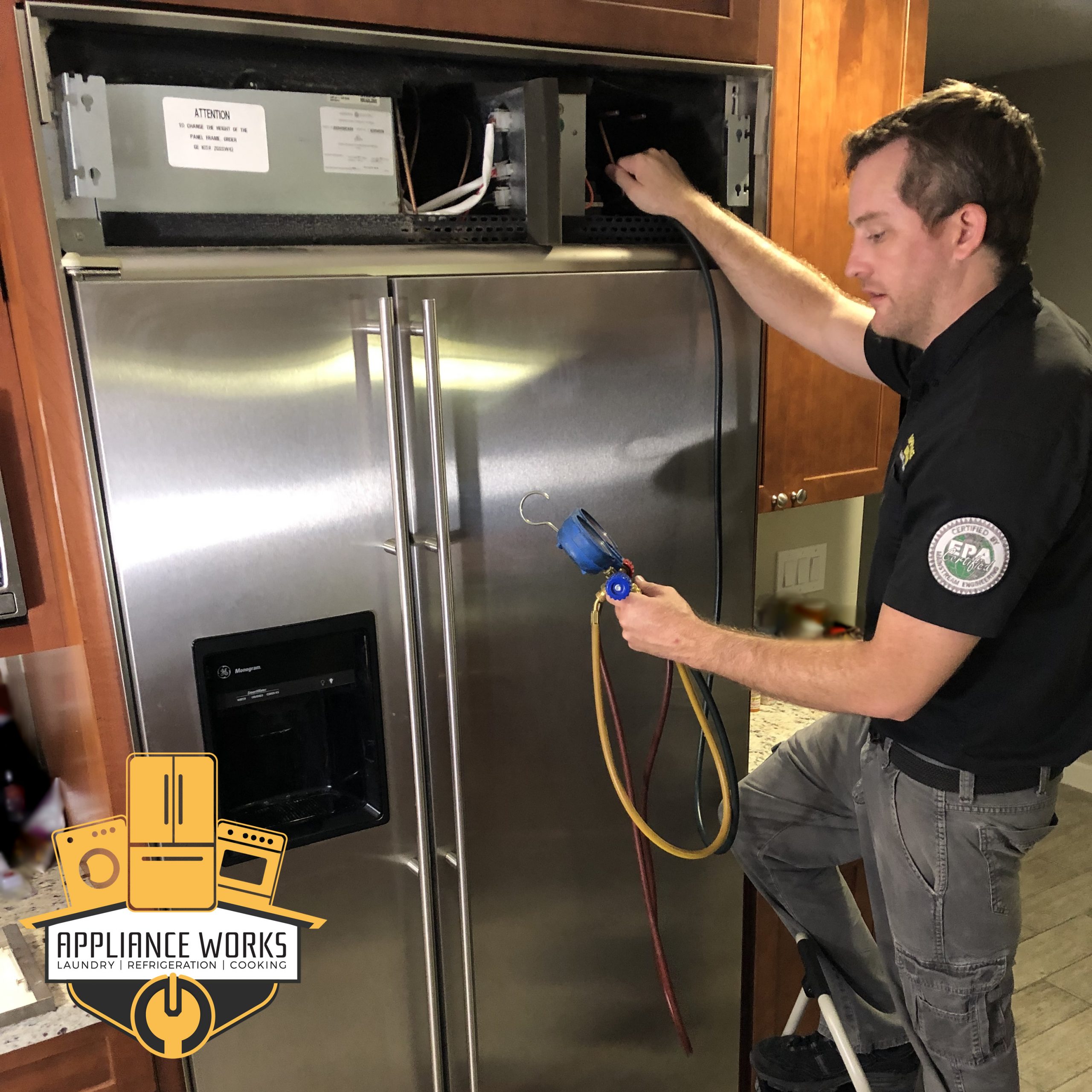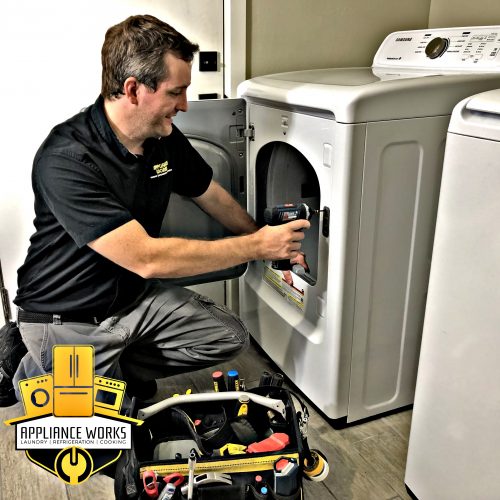Common Situations Requiring Best Sub-Zero Service Near You Dependable Refrigeration & Appliance Repair Service
Common Situations Requiring Best Sub-Zero Service Near You Dependable Refrigeration & Appliance Repair Service
Blog Article
The Ultimate Overview to DIY Appliance Repair Work Methods
From fridges to dishwashers, understanding exactly how to repair and fix these devices can save you time and money. Are you all set to discover important techniques that will equip you to take care of repairs confidently?
Comprehending Common Device Troubles
When you depend on your home appliances, it can be discouraging when they unexpectedly quit functioning or act up. Understanding common device issues can help you troubleshoot problems efficiently.
If your oven isn't heating, defective elements or thermostat concerns could be at fault. Dishwashers often experience problems with water drainage, so make certain the filter is tidy and the drain tube isn't kinked.
Likewise, pay attention for unusual sounds; they typically indicate mechanical problems. By recognizing these signs, you can save time and possibly prevent costly repair services. A little understanding goes a long means in preserving your devices, so remain educated to keep whatever running efficiently.
Essential Tools for DIY Repair Works
Prior to diving right into DIY home appliance repairs, it's important to collect the right tools to guarantee the process goes efficiently. Start with a great collection of screwdrivers, consisting of both flathead and Phillips, as they're vital for opening up most home appliances. You'll also desire a pair of pliers for gripping and turning cables or small elements.
Do not fail to remember a multimeter; it helps you examination electrical parts and identify problems effectively. A socket set comes in handy for loosening up or tightening screws, while an energy blade can be helpful for opening or reducing cords packaging.
Finally, think about having a flashlight handy to light up dark rooms inside your devices. With these crucial tools, you'll be fully equipped to take on different repair services, conserving both money and time. So, gather your equipment and prepare to roll up your sleeves!
Security First: Preventative Measures to Take
Before you start any kind of home appliance fixing, it's important to prioritize safety and security. Make sure you put on individual safety devices, disconnect the source of power, and keep your workspace arranged. These straightforward precautions can help avoid crashes and ensure a smoother repair work procedure.

Personal Protective Equipment
Safety and security equipment is a crucial component of any kind of Do it yourself appliance repair service job. Steel-toed boots are also a clever selection, particularly when lifting heavy devices. Remember, being prepared with the ideal equipment maintains you risk-free and focused on finishing your fixing effectively.
Source Of Power Interference
To assure a safe Do it yourself appliance repair work, disconnecting the power source is essential. This straightforward step protects against electric shocks and warranties that you can concentrate on the fixing without stressing concerning accidental activation. When you're certain that the power is separated, you can confidently continue with your fixings, understanding you've taken the needed preventative measures to shield yourself.
Workspace Organization
A well-organized workspace can make all the distinction in your DIY appliance repair task. Begin by clearing your work area of clutter to stop diversions and mishaps. Outline all your tools and materials, grouping similar items together for simple access. Use a tool kit or coordinator to keep tiny parts like screws and washing machines included and identified. Make certain you have actually got adequate lighting; it'll aid you see information plainly and reduce the danger of mistakes. Don't neglect to keep security equipment like handwear covers and goggles within reach. Have a trash bag convenient to dispose of waste without delay. A tidy room not just enhances efficiency however likewise keeps you secure while you function on your appliance repair.
Step-by-Step Overview for Refrigerator Fixes
When your fridge starts acting up, it can be aggravating, however taking on the trouble yourself can save you money and time. First, disconnect the refrigerator to assure safety and security. Look for usual concerns like temperature fluctuations or unusual noises. Inspect the thermostat setups; they might be set as well high if it's not cooling. Next, clean the condenser coils, which commonly gather dust and debris. For a loud refrigerator, examine the follower and confirm it's not blocked.
If there's water pooling within, inspect the door seals for damage or dust, and clean them if necessary. For ice build-up, clear the defrost drainpipe. When you've addressed the problem, plug the fridge back in and check it for a few hours. If the trouble lingers, you might need to change a damaged part, like the compressor or fan motor. Keep in mind, don't hesitate to consult the manual or seek professional assistance if needed.
Dealing With Cleaning Maker Concerns
Simply like refrigerators, washing machines can provide their very own set of difficulties, but numerous problems can be settled with a bit of troubleshooting. If your maker won't begin, examine the power cord and verify it's plugged in.
If your clothing aren't getting clean, think about the water level and detergent kind; using as well much cleaning agent can create excess suds, influencing efficiency. For leakages, analyze the hose pipes for splits or loose links. Tightening up these can frequently address the problem. Routine maintenance, like cleaning the filter, can protect against several problems from occurring. Remember, a little troubleshooting goes a lengthy way in maintaining your washing machine running efficiently.
Troubleshooting Stoves and Ovens
How can you troubleshoot usual issues with your oven check that or cooktop? Start by checking the power supply.
If your oven isn't home heating, examine the temperature level settings and confirm the door seals snugly. If it's damaged., a malfunctioning home heating component can likewise be the culprit; you may require to change it.
For unequal food preparation, rotate your pans and take into consideration making use of an oven thermometer to confirm exact temperature levels. If you listen to uncommon noises or smell gas, turn off the appliance instantly and consult an expert. By complying with these steps, you can determine and settle numerous usual stove and stove problems successfully.
Repairing Dishwashing Machines Facilitated
When your dishwashing machine starts acting up, it can be irritating, however dealing with typical problems isn't as tough as it seems. You'll learn detailed troubleshooting approaches that will certainly help you identify the issue, in addition to the important tools you'll need to deal with repair work yourself. Allow's make fixing your dish washer a breeze!
Common Dish Washer Concerns
While dishwashing machines are developed to make your life much easier, they can occasionally run into usual issues that leave you feeling annoyed. One regular problem is poor cleansing performance; this typically takes place due to stopped up spray arms or dirty filters. You might additionally discover water merging at the bottom, which can show a damaged drain or a kinked hose pipe. It could be an easy concern with the lock system or door seal if your dish washer's door won't latch. Furthermore, weird noises can indicate damaged components or loosened parts. Ultimately, if you smell something weird, it could be time to inspect for food debris or a malfunctioning electric motor. Resolving these problems early can save you time and inconvenience down the roadway (Best Sub-Zero Service Near You Dependable Refrigeration & Appliance Repair Service).

Detailed Troubleshooting
Before diving right into repair work, it's essential to recognize the particular issue your dish washer is facing. Begin by inspecting if it's not cleansing correctly. Check the spray arms for obstructions and warranty they spin freely. If you could try here it's leaking, analyze door seals and tubes for any kind of damage. For weird sounds, pay attention closely throughout cycles; foreign items may be stuck in the filter or impeller. Check the power supply and door latch if your dish washer will not start. Don't forget to consult your individual guidebook for repairing suggestions particular to your version. By carefully attending to each potential concern, you can determine the trouble and take the necessary actions to repair it, making your dishwasher function fresh once more.
Necessary Repair Tools
Having the right devices at your disposal can make all the distinction when fixing your dish washer. Do not neglect a pail or towels for any kind of water spills during repairs.
If you're dealing with blockages, a drain serpent or a samsung washer repair wet/dry vacuum cleaner will certainly be invaluable. You might additionally want a level to ensure your dishwashing machine's properly lined up. Safety equipment like safety glasses and handwear covers will certainly shield you while you function. With these essential devices, you'll be well-appointed to deal with any dishwashing machine repair work obstacle that comes your way.
Often Asked Questions
Just how Do I Determine if an Appliance Is Well Worth Repairing?
To identify if an appliance's worth fixing, consider its age, repair service costs, and existing value. You could desire to spend in a brand-new model rather - Best Sub-Zero repair Service Dependable Refrigeration & Appliance Repair Service. if repair work go beyond half the substitute price.
Can I Discover Replacement Components In Your Area for My Device?
Yes, you can typically find replacement components in your area for your device. Inspect hardware shops, home appliance fixing stores, or regional classifieds. Don't fail to remember to bring the design number to ensure you obtain the appropriate component!
What Usual Mistakes Should I Stay Clear Of When Fixing Devices?
When repairing home appliances, prevent rushing through diagnostics, ignoring safety preventative measures, or using inaccurate tools. Do not avoid checking out manuals or enjoying tutorials; they give essential assistance. Hold your horses and detailed to ensure successful repairs and stop additional damage.
For how long Does a Normal DIY Home Appliance Fixing Take?
A common do it yourself device fixing typically takes one to 3 hours, depending on the complexity. You'll intend to collect your materials and devices first, and comply with instructions thoroughly to avoid unneeded delays.
Exist Any Type Of Warranties for Do It Yourself Appliance Repair Works?
When you tackle do it yourself appliance repair work, guarantees normally do not cover your work. However, some makers could honor warranties for parts you change. Always check your home appliance's service warranty terms prior to starting any kind of fixings to prevent concerns.
Before diving into DIY home appliance fixings, it's important to gather the right tools to guarantee the process goes smoothly.Prior to you start any kind of appliance repair work, it's necessary to focus on security.To assure a safe Do it yourself home appliance repair, detaching the power resource is crucial.An efficient work location can make all the distinction in your Do it yourself device repair work task. Always check your device's guarantee terms before starting any type of repairs to prevent issues.
Report this page